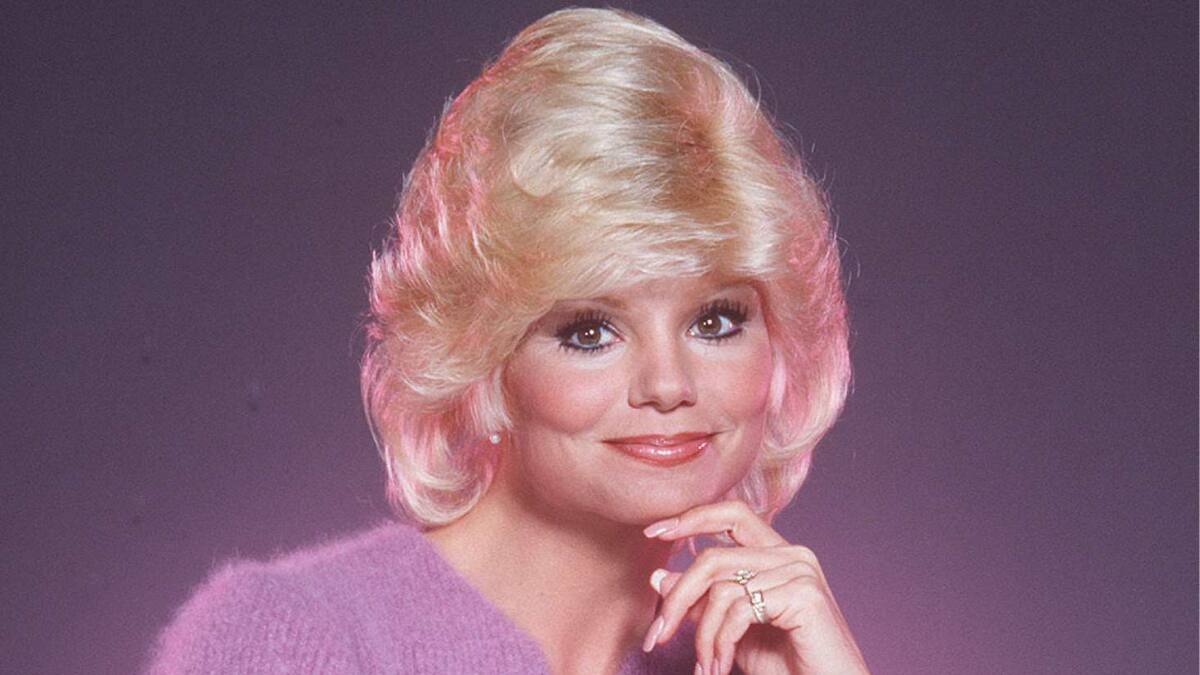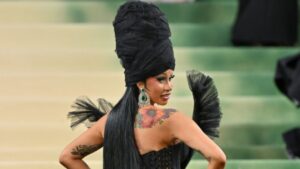There was a time in Hollywood when blonde meant one thing: decoration. It was a visual shorthand — a role cast before the actress even spoke her first line. And yet, Loni Anderson, with her platinum hair and pin-up looks, refused to be confined by the frame others built for her. She walked into America’s living rooms as Jennifer Marlowe, the smart and statuesque receptionist on WKRP in Cincinnati, and walked out with something far rarer than fame: control.
Anderson didn’t just play a role — she played the system. In an industry that devoured the very icons it created, she remained. Not through controversy or reinvention for reinvention’s sake, but through a kind of quiet mastery: of image, of message, of myth. Her name still floats through pop culture not just as a nostalgic footnote, but as a symbol of elegance, wit, and surprising resilience.
This isn’t just a story of survival in Hollywood. It’s a story of branding before the word meant hashtags and merch drops — a woman who understood her power, refined it, and never let it be used against her.
Breaking Out of the Box: The WKRP Effect and Strategic Visibility
The Role That Launched a Persona, Not Just a Career
When WKRP in Cincinnati first aired in 1978, it might have looked like just another ensemble sitcom. But Loni Anderson’s portrayal of Jennifer Marlowe — the bombshell receptionist who was always the smartest person in the room — was quietly revolutionary. She wasn’t a punchline. She was the punchline’s deliverer.
With razor-sharp timing, unflinching poise, and a voice that wrapped confidence in velvet, Anderson crafted a character who disrupted the dumb blonde trope without ever disowning the glamour that came with it. “Jennifer never used her looks,” Anderson once said in an interview. “She simply owned them — like a man owns his suit.” That distinction stuck with audiences. She wasn’t performing beauty. She was commanding the room with it.
In a television landscape dominated by loud archetypes and laugh tracks, Jennifer Marlowe’s quiet control was magnetic. And Anderson knew exactly what she had created — a character who blurred the line between fiction and personal brand. From that moment forward, she wasn’t just Loni Anderson the actress. She was Loni Anderson, the icon.
Early Image Management in a Pre-Digital Era
Before Instagram filters and viral tweets, image control in Hollywood was a high-stakes chess game — and Loni Anderson played it with rare precision. In the late ’70s and early ’80s, the ecosystem of fame was ruled by gatekeepers: publicists, studio heads, talk show bookers, and tabloid editors. Every appearance was curated, every quote potentially career-defining.
Anderson, often underestimated because of her looks, understood this machinery better than most. She wasn’t just posing for TV Guide covers — she was crafting a consistent visual language: bombshell but elegant, polished but not inaccessible. On The Tonight Show, she answered questions with warmth and wit, always walking the fine line between being personable and unknowable.
She leveraged the press the way a modern influencer might leverage an algorithm. Strategically timed interviews, selective visibility, and an ironclad boundary between personal vulnerability and public presentation. In an era where women were often shaped by the press, Loni shaped her silhouette — and in doing so, taught the media how she wanted to be seen.
The Hollywood Businesswoman: Reinvention in the 80s and 90s
Licensing the Look — Glamour as Intellectual Property
Loni Anderson didn’t just wear glamour — she licensed it, lived it, and turned it into a long-term asset. While many of her contemporaries allowed the studios or stylists to define their image, Anderson approached her appearance like a brand manager. Her signature style — golden waves, curve-hugging gowns, a soft-spoken confidence — became instantly recognizable across formats: from magazine spreads to late-night television, from film stills to fan memorabilia.
In the early 1980s, she negotiated photo approval rights and styling input for press shoots — rare for actresses at the time. Her 1983 Playboy cover is a prime example: striking, poised, and on-brand — a moment captured among her rare Hollywood studio memories, reflecting not exploitation but agency. In interviews, she framed glamour as strength, not spectacle, echoing messages that resonated with working women who admired her control as much as her beauty.
Her film choices, even in popcorn fare like Stroker Ace, reinforced her image without diluting it. She wasn’t chasing Oscar bait; she was maintaining market value. Loni’s aesthetic was more than costume — it was currency. By refining rather than reinventing, she created a blueprint: how to turn physical presentation into lasting professional capital without compromising credibility or craft.
Navigating Typecasting Without Losing Relevance
Loni Anderson knew the box she’d been placed in — and instead of fighting it head-on, she learned to reshape its edges. Hollywood in the ’80s didn’t reward deviation from type, especially for actresses whose fame had been built on beauty. The challenge wasn’t just staying visible — it was staying relevant without alienating the very audience that put her there.
She accepted roles that fit her public image — glamorous, poised, often comedic — but she quietly pushed for variation within the mold. In A Letter to Three Wives (1985), she played against type with more emotional texture. In made-for-TV movies and dramas, she took on maternal roles, tackling themes like family dysfunction and illness — still elegant, but more grounded. Her choices signaled a shift: not rejection of the past, but evolution from it.
Anderson didn’t disappear to escape typecasting; she stayed present enough to remain familiar, while choosing roles that slowly expanded her range. She played the long game, recognizing that relevance isn’t about constant reinvention — it’s about strategic movement within the frame you’re given.
Off-Screen Strategy: Personal Life as Brand Architecture
Tabloids, Marriages, and Maintaining Control of the Narrative
Loni Anderson’s personal life — especially her high-profile marriage to Burt Reynolds — often dominated headlines, but rarely defined her. At the height of their relationship in the 1980s, they were Hollywood’s golden couple: red carpet regulars, tabloid fixtures, and the subject of relentless speculation. Yet even as their marriage unraveled in the public eye, Anderson maintained a posture of restraint that contrasted sharply with the era’s appetite for scandal.
Rather than exploit the drama, she chose silence — or, when necessary, measured response. During their tumultuous divorce, she issued calm, prepared statements while the press circled for conflict. It wasn’t avoidance; it was strategy. Anderson understood that public perception wasn’t just shaped by what you said, but by what you chose not to say.
That silence became its form of authorship. She allowed the media storm to swirl while preserving the integrity of her brand — poised, private, in control. In a time when actresses were often at the mercy of media narratives, Loni Anderson proved she could participate in the spectacle without being consumed by it.
Philanthropy and Personal Advocacy as Trust Signals
For Loni Anderson, advocacy wasn’t a celebrity add-on — it was an extension of the values she’d subtly communicated all along: resilience, care, and control. As her public persona matured, so did her willingness to speak on matters that touched her personally. One of her most visible causes became COPD awareness, a disease that had deeply affected her family. Rather than lend her name passively, Anderson became an active spokesperson, sharing stories, appearing in public service campaigns, and using interviews to bring visibility to a condition often overlooked.
This move wasn’t performative — it was lived. By tying her advocacy to real-life experience, she deepened audience trust and redefined what it meant to age in the spotlight with purpose. She also became involved in elder care initiatives and literacy programs, reflecting a commitment to nurturing the very audiences that had grown up with her.
In aligning her platform with causes rooted in empathy and lived experience, Anderson added a new dimension to her brand — one not built on glamour, but on grounded, credible humanity.
Mirror, Mirror: How Loni’s Brand Stands Against Her Peers
The late 70s and 80s were a golden age for blonde television icons — an era that catapulted women like Farrah Fawcett, Suzanne Somers, Heather Locklear, and Loni Anderson into homes and hearts across America. Each cultivated a brand rooted in beauty and charm, but the strategies behind their public images reveal distinct paths through the labyrinth of fame.
Farrah Fawcett exploded onto the scene with Charlie’s Angels, her tousled hair and red swimsuit immortalized in posters. Her brand evolved into something raw and artistic in later years, marked by challenging roles and a public cancer battle that reframed her image with courage and vulnerability.
Suzanne Somers leaned into wellness and entrepreneurship post-Three’s Company, becoming a spokesperson for hormone therapy and fitness — a brand pivot that capitalized on reinvention and consumer trust.
Heather Locklear, with her roles in Dynasty and Melrose Place, exuded slick, serialized sex appeal, anchoring her brand in high drama and tabloid appeal, especially in the 90s.
Loni Anderson, by contrast, played the long game with quiet control. She didn’t reinvent so much as refine — sticking to her signature look, selectively choosing roles, and protecting her narrative. Her glamour never felt commodified; it was curated. Her public presence, while visible, never strayed into spectacle or overexposure.
| Celebrity | Signature Role | Brand Pillar | Public Strategy |
| Loni Anderson | WKRP in Cincinnati | Elegant consistency | Strategic visibility |
| Farrah Fawcett | Charlie’s Angels | Beauty turned bravery | Bold reinvention, public truth |
| Suzanne Somers | Three’s Company | Reinvented wellness guru | Entrepreneurial branding |
| Heather Locklear | Melrose Place | Sexy drama queen | Soap opera star + tabloid draw |
What sets Anderson apart isn’t that she defied the mold — it’s that she mastered it on her terms, proving that endurance could be a brand in itself.
A Brand that Ages with Grace: Modern-Day Relevance
From TV to TikTok — How Loni’s Legacy Is Being Rediscovered
Loni Anderson may have built her brand in an analog world, but her legacy is finding new life in digital spaces she never had to court. On TikTok, Gen Z creators remix clips of WKRP in Cincinnati, marveling at her poise and comedic timing. On Instagram, fan pages post vintage red carpet photos that somehow feel more relevant — and more radical — in an era obsessed with authenticity.
Streaming platforms have introduced her work to new audiences, while podcasts and YouTube retrospectives frame her as both an icon and a case study in image mastery. Nostalgia isn’t just bringing her back — it’s reframing her.

What keeps her image alive isn’t just the allure of retro glamour. It’s that Anderson’s version of timelessness feels earned. She didn’t disappear or rebrand; she maintained. And in a culture addicted to reinvention, there’s something quietly defiant — even inspiring — about a star who never had to beg for attention to deserve it.
Ageless Appeal and the Myth of Youth in Hollywood
In an industry that often treats aging like a slow fade to black, Loni Anderson has stayed remarkably — and purposefully — visible. But she didn’t do it by chasing youth. She did it by refusing to treat age as a liability.
Well into her 60s and 70s, Anderson continued appearing in TV movies, red carpet events, and talk shows — not as a novelty, but as herself. She’s been open about aging gracefully, advocating for confidence over cosmetic extremes. In interviews, she’s spoken candidly about health, family, and self-worth — topics that resonate with multi-generational audiences seeking substance beneath the surface.
There’s a difference between surviving Hollywood and outsmarting it. Anderson did the latter by aging in alignment with her brand — poised, polished, present. She didn’t vanish or radically reinvent. Instead, she evolved with intention, proving that allure isn’t about clinging to youth, but owning your place in time with absolute self-awareness.
“When I Met Loni”: A First-Person Take on Legacy
It was a fundraiser for children’s hospitals — one of those low-key Los Angeles galas where you expect to see maybe a B-lister from a ’90s sitcom, not actual icons. But there she was: Loni Anderson, standing by the silent auction table in a pale blue suit that matched her eyes almost exactly, her posture as upright and composed as it had been on TV sets decades earlier.
I was a junior entertainment reporter then, starstruck but trying hard not to show it. I introduced myself and asked if she’d mind a quick quote for the magazine. She smiled — warm, patient — and said, “Of course, honey. You came all this way.”
What struck me wasn’t just how good she looked — though yes, she did. It was her awareness. She knew how to read a room, how to make the people around her feel seen. She offered thoughtful answers about the event, then pivoted the conversation toward me: Where was I from? How long had I been writing? She had a way of making the spotlight feel shared, not stolen.
Later, I watched her chat with nurses and donors with the same grace she’d shown on camera. No handlers, no rushing. Just presence.
You expect celebrities to shrink off-screen. Loni didn’t. She expanded. Not in volume, but in gravity. That night taught me something PR statements never could: her brand wasn’t a performance. It was a commitment — to elegance, to connection, and to owning every room without ever having to raise her voice.
What Loni Anderson Teaches Us About Brand Longevity
Loni Anderson didn’t just survive Hollywood — she studied it, shaped it, and stayed in control of her narrative. Her story isn’t just about talent or timing. It’s about strategy, restraint, and self-awareness.
She reminds us that in an industry obsessed with reinvention, refinement is a more powerful tool. You don’t have to shout to stay relevant — you just have to know what you stand for.
Here’s what her legacy teaches:
- Own your image before others define it.
- Stay visible, but don’t overshare.
- Turn glamour into currency, not camouflage.
- Age in alignment with your truth — not the timeline others expect.
- Make your brand about substance, not just style.
Loni Anderson didn’t ride a wave. She learned how to steer it. And decades later, we’re still watching — not because she demanded attention, but because she earned lasting presence by design.
Mohit Wagh is the co-founder of The Graval with over 10 years of experience in SEO and content strategy. He specializes in crafting data-driven, authoritative content that blends cultural insight with digital growth.





4 thoughts on “How Loni Anderson Crafted a Timeless Hollywood Brand Across Decades”